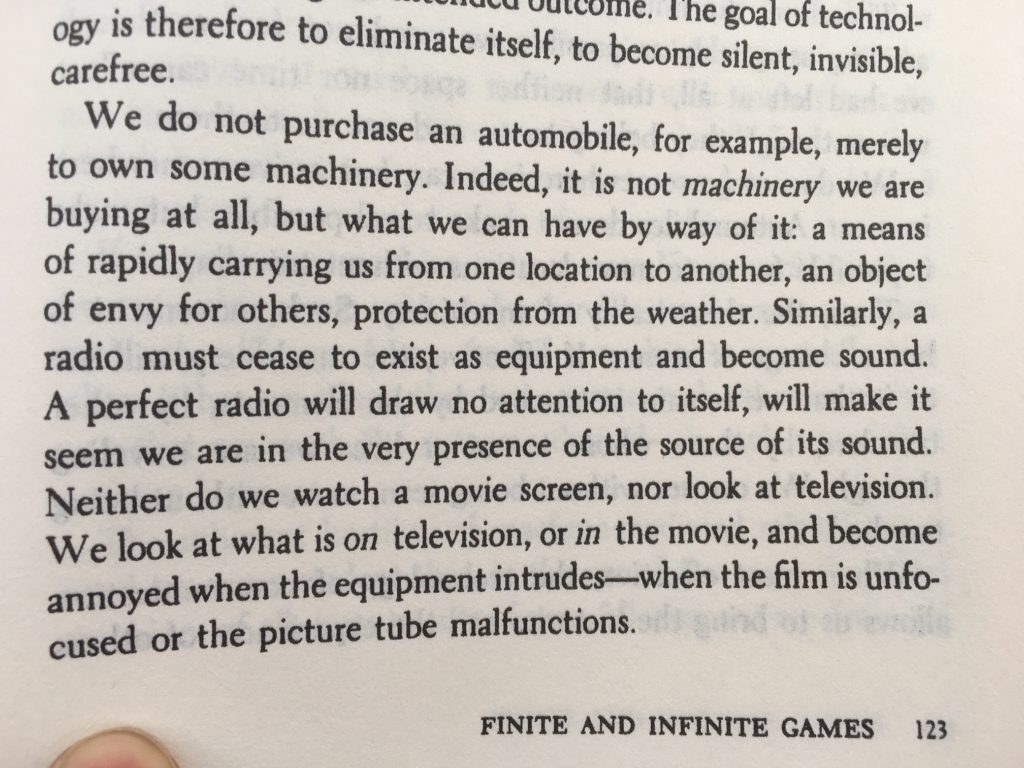If you are an engineer, the title of this article may shock (or even offend) you. But if I rephrase, I’ll merely state what’s immediately obvious: people are motivated towards achieving their goals and technology is simply the means towards that end (and not an end in itself). This holds true even for engineers. When they get excited about new technology (say, a new programming language), they’re responding to their intrinsic motivations of exploration, competence, social acceptance (or even aesthetic appreciation).
This concept of technology being subservient to human motivations crystallized for me as I read the book Finite and Infinite Games. One paragraph particularly stood out to me:

Without realizing it, James Carse (the author) articulated the Jobs to be Done (JTBD) theory that’s currently on the rise in product and design community. A job in JTBD’s context is whatever user is motivated for. It is why the user “hired” your product. The job could be emotional (having fun, bonding with friends, going out for dinner) or functional (fixing a broken car, shopping for groceries).
What I like about JTBD is not just that articulates demand but it broadens the concept of competition. Because of our cognitive biases, it’s very hard to have a broad view of the world. From our inside-out view, our brains consider only very similar objects as related. Say, for Wingify’s first product VWO (an A/B testing platform), for a very long time I considered only other A/B testing platforms as competition. I believed that to succeed, what we needed was to be better than other competing products.
But as my perspective broadened (thanks to Alan Klement’s When Coffee and Kale Compete and Christensen Clayton’s Competing Against Luck), it became obvious that VWO was being hired for fulfilling several different levels of customer motivations.

Three points are worth noting in the diagram above.
1. Users define competition, not product designers
VWO’s competition comes not just from other A/B testing products, but from everything else that user chooses himself. That’s why an entrepreneur shouldn’t define competition, he should discover it by studying customer behavior. He should constantly ask what else is my customers (and non-customers) using to achieve the same goal that they’re hiring my product for. Facebook understands this really well and that’s why it bought WhatsApp and Instagram. All social networks (online or offline) compete with each other.
2. A competitor at another level of user motivation can render your product obsolete
I feel that VWO’s biggest competition could come from an AI technology that obviates the need to A/B test. Wouldn’t it be great for the user to instantly and reliably know in advance which version is going to perform better? So an entrepreneur should also be constantly anticipating if a new technology could enable the customer to do what she wants to do in a less costly manner. This is also why, at the expense of alienating its cash cow (human drivers), Uber is interested in self-driving cars.
3. A technology or product competes with not doing anything
Note in the diagram above that many alternatives to VWO do not require any technology. They’re what all humans are able to do without technology: persuade others, do nothing, lower expectations, etc. This is the reason why Netflix’s CEO considers sleep as their biggest competition. It’s not an ethical view, but he’s right: every time you are sleeping, you are not watching Netflix.
Technology often comes with a cost requirement and people constantly evaluate what is being asked of them (cost of discovering, acquiring, operating and owning technology) vs benefits they’ll get. If a human can get all benefits that a technology promises without costs or hassles of a technology, he or she will take that offer. For example, mindfulness and meditation doesn’t require any technology and yet for many people, it’s beating smartphones in our desire to feel fulfiled. From my previous article on Why people jump red lights and what it says about startup failure:
Customers consider multiple costs (money, time, effort, cognitive load, reputation) while making the tradeoff of cost vs benefit. Their expectation of potential benefit continuously changes as they gain more experience with a product or a company (however new products usually fail because customers never got to a point of gaining enough experience to derive full value from those products)
I could also have phrased the same sentence as costs are whatever’s expected of them to spend to get a benefit they want. If I’m motivated to listen to the music, I have a number of options: playing music on my phone, switching on the radio, putting on a playlist on Youtube on laptop, attending a live band that’s playing nearby or simply singing it myself. Technology is a means to a human’s end, and not an end itself.
With this outside-in perspective, direct competitors become a smaller concern and the potential for growth increases. It impacts everything: from what marketing does (what to write, who to write for, how to persuade them) to product design (what to build next) to sales (how to convince disinterested prospects).
So as the old saying goes, if you run railroads, it’s worth remembering that, you’re in the human (or things dear to humans) transportation business. And that your biggest competitor could be Skype, not airplanes.
How would you design a new social network?
Dear reader, if you have read so far, I have a question for you that’s related to this article.
If you were a psychologist designing a new kind of social network, what would it look like?
I’ll RT interesting ideas and link in my article.
— Paras Chopra (@paraschopra) December 13, 2017
Tweet your response to me as a reply to this thread and I’ll retweet the most intriguing responses. In the same thread, you can also check out and comment on what others proposed.
Join 150k+ followers
Follow @paraschopra